 Signin with Google
Signin with Google Signin with Facebook
Signin with Facebook

 Places,Culture,History
Places,Culture,HistoryNaqsh-e Jahan Square, the Pattern of the World

As you step into Naqsh-e-Jahan Square, UNESCO- listed heritage, you’ll find yourself watched and guarded on all four sides. All sides of this rectangular-shaped square are in alignment with the four geographical directions and are decorated with four bazaars, Imam (Shah) Mosque, Sheikh Lotfollah Mosque, Ali Qapu Palace and Qeysarieh Bazaar. These are not only the jewels of this adornment but each of them has been perfectly tailored to be signatures of Isfahan.
Pacing the pavements of Naqsh-e-Jahan square can make you feel like you’re on a time travel. You may be strutting through a garden or walking on a polo ground. You can also find yourself in the middle of an army parade, a Safavid royal or a religious celebration. You can be a tradesperson or a businessman in Isfahan’s Grand Bazaar looking to buy or sell goods.
This historical square which was once a Persian Garden called Naqsh-e-Jahan has survived many dynasties, from the Timurids and Aq Qoyunlus to Seljuks, Safavids, Qajars and Pahlavis. If it could speak, it could narrate a story about all the things it has been through. But given the circumstances, we are honoured to tell you the story on its behalf.
The birth of Naqsh-e-Jahan Square and the ideology
Prior to the rise of Safavids, the first Shiite government in Iran, Isfahan became the capital of the kingdom. This beautiful garden and its mansions remained afoot until the Seljuk era. It took a while for the Safavids to choose Isfahan as their capital since they started off with Tabriz and Qazvin. Naqsh-e-Jahan’s lexical meaning is “The pattern of the world”. But mystical, mythical and philosophical concepts behind this name have given it a mysterious attribute.
Naqsh-e-Jahan was, in fact, a way of thinking and choosing Naqsh-e-Jahan garden/ square as the capital of the dynasty and symbol of the whole world was directly tied with Sufism and mysticism. This ideology and outlook were based on a pivotal point of view. As every powerful government used to consider itself the centre of the world, where the whole world and its occurrences were summed up in. All of the buildings and structures around this square were symbols of different social and royal positions.
The Great Shah-Abbas I the 5th Safavid king, celebrated the first days of his rule by expanding the “Darb-e-Kooshk” square in Naqshe-e-Jahan Garden and changing its name to “Shah Square”. According to Jean Chardin, a famous French jeweller and traveller, more than fifty thousand lights illuminated the square, during those celebrations. Imagine the celebratory feeling it would convey to the public!
Jewels of Naqsh-e-Jahan Square
Ali Qapu Palace the Political Symbol
What you see now as the “Ali-Qapu” palace on the west side of the square used to be a square called “Darb-e-Kooshk” which was a place where Persians held their traditional rituals such as Nowrouz. The foundations of this 6-storey palace were set during the reign of Shah Abbas I and it was completed through five different architectural stages. The real treasures of Ali-Qapu palace are hidden on the top floor, in a room known as the music room which is decorated with uniquely beautiful stuccos. Ali Qapu Palace which was symbolized as the political hub of the kingdom was the tallest building and structure of its own time that later Shams Ol emareh overtook its place in the Qajar era.

Shah Mosque, the symbol of social Power efflorescence
Calling Naqsh-e-Jahan Square an ornament is not for nothing. Wait until you’ll be mesmerized by the Shah Mosque, on the southern side of the square. The exteriors of the mosque will draw you in, boasting its beautiful woodworks, Sols calligraphies, tilings, symmetrical arcades and famous marble pool. Shah Abbas I wanted the Shah Mosque to be perfect, which is why in the 24th year of his reign, he found famous architects and calligraphers who were able to implement what he had in mind. He impatiently awaited the completion however the construction took longer than expected.
When Shah Abbas I of Safavid moved his empire from Qazvin to Isfahan in 1598, he desired to have a royal mosque completed during his reign and lifetime. The construction began in 1611, and the final works on the mosque were made in late 1629, a few months after the king’s death.
Shah Abbas did not know how his favourite mosque will be the point of admiration and perhaps he never had thought of the mosque being registered, along with the Naqsh e Jahan Square, as a UNESCO World Heritage Site 400 years later.
But the essential mystery of the Shah Mosque is not only the seven-coloured tile mosaics and its unblemished unity of the overall design but the mosque’s south dome. It is a Renaissance Persian dome building affiliated with acoustic properties. You just need to stand right under the central point of the dome to convey your voice to the whole main sanctuary.
In the time when there was no amplifier or speaker, the genius architects used smooth tiles and calculated the angles to feature the reflection under the dome’s central point to enable the cleric to speak with a low voice and still be heard clearly by everyone inside the building.

Sheikh Lotfollah Mosque, the religious status of the Shiite rule
Adding Sheikh Lotfoallah Mosque to this precious collection brought light and colour to the square. With its one-of-a-kind Iranian Islamic architecture and beautiful tilings, it still leaves people gazing at its sky-blue-lemon tiles. Sunshine at different times of day makes the tiles look different in colour. The eye-catching collaboration of light and colour during sunrise and sunset brings out two different verses of the Quran at sunrise and sunset. One refers to the sun and the other refers to the moon.

There’s no way you’re going to miss this eye-catching piece of jewel on the eastern side of the square. On a side note, the distinguishing characteristic of this mosque from the other mosques is that it doesn’t have any minarets, which is religiously odd in terms of architecture.
Qeysarieh Bazaar, the symbol of economic centralisation
Qeysarieh Bazaar and its beautiful portal is the gate to another world. Leading to a mercantile side of Isfahan, consisting of various rows each called by their own names with the prefix “Rasteh”. Rasteh Samovar, Makhlas, Shaleh and etc. As a part of Isfahan’s Grand Bazaar, this bazaar holds a very special place. Qeysarieh Bazaar which used to be a three-storey bazaar is currently reduced to two floors. However, it still remains one of the most privileged Bazaars in Iran.

Social life and lifestyle
Chogan, the game of the kings and lifestyle
“Naqsh-e-Jahan” square was literally the centre of everything during the reign of Shah Abbas I. Not only it was a place for royal feasts and celebrations but it was also utilized as a Chogan (polo) field. This horse-riding game goes along with music and storytelling has over 2000 years of history in Iran inscribed on the list of intangible cultural heritage by UNESCO in 2017. The only remnants of this traditional Iranian sport which is called Chowgan in Farsi, are short stone pillars on the southern side of the square. As a remembrance of this Iranian traditional sport, symbolic polo matches are held every year in Naqsh-e-Jahan square.
Friday Markets
Friday markets of Shah Square were one of the famous markets and it was people’s favourite hangout. It provided them with the opportunity to sell things and find whatever it was that they needed.
Shah Square is still regarded as an “Iranian Square” template. But that’s not it! The multipurpose utilization of the square and coexistence of mercantile, religious and governmental buildings alongside each other is its prominent characteristics. These buildings have not only complemented one another but have peacefully neighboured each other all throughout history.
By Sara Kheirdoust / TasteIran
